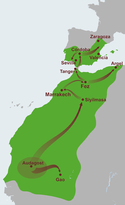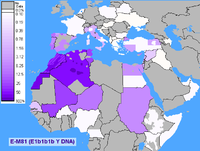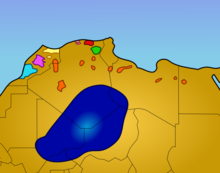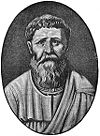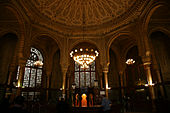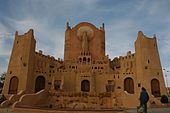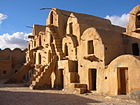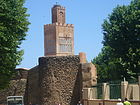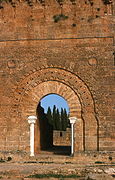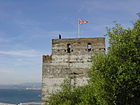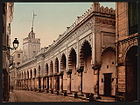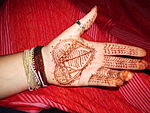- Berber people
-
Berbers
Imazighen / ⵉⵎⴰⵣⵉⵖⴻⵏRegions with significant populations  Morocco
Morocco Algeria
Algeria Tunisia
Tunisia Libya
Libya Mauritania
Mauritania Mali
Mali Niger
Niger Egypt
EgyptWestern Sahara Diaspora:  Europe
Europe Canada
Canada United States
United States1,327 (2000) [1] Languages Berber languages (primary), Arabic.
Foreign languages: English, French, Italian, Spanish.Related ethnic groups Berbers (Berber: ⵉⵎⴰⵣⵉⵖⴻⵏ/Imazighen / Imaziɣen) are the indigenous peoples of North Africa west of the Nile Valley. They are continuously distributed from the Atlantic to the Siwa oasis, in Egypt, and from the Mediterranean to the Niger River. Historically they spoke the Berber language or varieties of it, which together form a branch of the Afro-Asiatic linguistic family. Today, varieties of Maghrebi colloquial Arabic are spoken by a large portion of Berbers besides the Berber language itself. Foreign languages like French are used by the educated in Morocco, Tunisia and Algeria. Spanish is also known by some Berbers in Morocco and in the annexed Western Sahara and Italian in Libya. This presence of European languages was due to Europe's occupation and colonization of the Berber world. Today, most Berber-speaking people live in Morocco, Algeria, Tunisia, Libya, Western Sahara, Mauritania, Mali and Niger, as well as various diasporas from these countries (particularly in France).[2][3]
The presence of the Arabic language and dialects is due to the spread of Islam and to the immigration of some Arab tribes to the region centuries ago. A Berber is not necessarily only someone who happens to speak Berber. The Berber identity is usually wider than language and ethnicity, and encompasses the entire history and geography of North Africa. Berbers are not a homogenous ethnic group and encompass a range of phenotypes, cultures and ancestries. The one unifying force is the Berber language and an identification with the Berber heritage and history.
Many Berbers call themselves some variant of the word Imazighen (singular: Amazigh), possibly meaning "free people" or "free and noble men"[2] (the word has probably an ancient parallel in the Roman name for some of the Berbers, "Mazices").
The best known of the ancient Berbers are the Numidian king Masinissa, the Berber-Roman author Apuleius, Saint Augustine of Hippo, and the Roman general Lusius Quietus, who was instrumental in defeating the major wave of Jewish revolts of 115–117. Famous Berbers of the Middle Ages include Tariq ibn Ziyad, a general who conquered Hispania; Abbas Ibn Firnas, a prolific inventor and early pioneer in aviation; Ibn Battuta, a medieval explorer who traveled the longest known distances in pre-modern times; and Estevanico, an early explorer of the Americas. Well-known modern Berbers in Europe include Zinedine Zidane, a French-born international football star of Algerian Kabyle descent, and Ibrahim Afellay, a Dutch-born footballer of Moroccan Riffian descent.
Contents
Name
The name Berber appeared for the first time after the end of the Roman Empire.[4] The use of the term Berber spread in the period following the arrival of the Vandals during their major invasions. A history by a Roman consul in Africa made the first reference of the term "barbarian" to describe Numidia. Muslim historians, some time after, also mentioned the Berbers.[5] The English term was introduced in the 19th century, replacing the earlier Barbary, a loan from Arabic. Its ultimate etymological identity with barbarian is uncertain, but the Arabic word has clearly been treated as identical with Latin barbaria, Byzantine Greek βαρβαρία "land of barbarians" since the Middle Ages.
According to Leo Africanus, Amazigh meant "free men," though this has been disputed, because there is no root of M-Z-Gh meaning "free" in modern Berber languages. It also has a cognate in the Tuareg word "amajegh," meaning "noble".[6][7] This term is common in Morocco, especially among Central-Upper-North Morocco Tamazight and Central-Upper-North-South Morocco Sous Tamazight speakers in 1980,[8] but elsewhere within the Berber homeland a local, more particular term, such as Kabyle or Chaoui, is more often used instead in Algeria.[9]
The Egyptians, Greeks, Romans, and Byzantines mentioned various tribes with similar names living in Greater "Libya" (North Africa) in the areas where Berbers were later found. Later tribal names differ from the classical sources, but are probably still related to the modern Amazigh. The Meshwesh tribe among them represents the first thus identified from the field. Scholars believe it would be the same tribe called a few centuries after in Greek Mazyes by Hektaios and Maxyes by Herodotus, while it was called after that the "Mazaces" and "Mazax" in Latin sources, and related to the later Massylii and Masaesyli. All those names are similar and perhaps foreign renditions to the name used by the Berbers in general for themselves, Imazighen.
Prehistory
Northern African cave paintings, dating back 12 000 years, have been found at Tadrart Acacus in Libya. A Neolithic culture, marked by animal domestication and subsistence agriculture, developed in the Saharan and Mediterranean region (the Maghreb) of northern Africa between 6000 B.C and 2000 B.C. This type of life, richly depicted in the Tassili n'Ajjer cave paintings of southeastern Algeria, predominated in the Maghreb until the classical period. The proto-Berbers lacked a written language and so have tended to be overlooked by written historical accounts.[citation needed]
The modern Berbers are assumed[by whom?] to be descended from the tribes of Ancient Libya which are mentioned in records of Ancient Egypt. During the New Kingdom, the Egyptians later fought against the Meshwesh and Libu tribes on their western borders.
During the pre-Roman era, several successive independent states (Massylii) existed before the king Masinissa unified the people of Numidia.[10][11][12][10][13][14]
History
In historical times, the Berbers expanded south into the Sahara (displacing earlier populations such as the Azer and Bafour), and have in turn been mainly culturally assimilated in much of North Africa by Arabs, particularly following the incursion of the Banu Hilal in the 11th century.
The areas of North Africa which retained the Berber language and traditions have, in general, been the highlands of Kabylie, Aures (in Arris, T'kout) and Morocco, most of which in Roman and Ottoman times remained largely independent the Ottoman did penetrate the Kabylie area resulting in many of the Turkish culture can be seen in the food, clothes and music, and where the Phoenicians never penetrated far beyond the coast. These areas have been affected by some of the many invasions of North Africa, most recently that of the French.
Origins
Further information: Genetic history of North Africa and Proto-Berber languageThe prehistoric populations of North Africa are related to the wider group of Paleo-Mediterranean peoples. The Afroasiatic phylum probably originated in the mesolithic period, perhaps in the context of the Capsian culture.[15][16] By 5000 BC, the populations of North Africa are an amalgamation of Ibero-Maurisian and Capsian stock blended with a more recent intrusion associated with the Neolithic revolution.[17] Out of these populations, the proto-Berber tribes form during the Late Bronze to Early Iron Age.[18]
Antiquity
The Berbers enter historicity gradually during the Roman era. The oldest known Tifinagh inscription is dated to ca. 200 BC.[citation needed] Byzantine authors mention the Mazikes (Amazigh) as tribal people raiding the monasteries of Cyrenaica.
Roman era Cyrenaica became a center of Early Christianity. Some pre-Islamic Berbers were Christians[19] (some evolved their own Donatist doctrine),[20] some were Jewish, and some adhered to their traditional polytheist religion. Roman era authors of Berber background include Apuleius and St. Augustine. There were threes of possible Berber ancestry who came from the Roman province of Africa. Pope Victor I served during the reign of Roman emperor Septimus Severus, who was a North African of Roman/Punic ancestry (perhaps with some Berber blood).[21]
Numidia
Numidia (202 BC – 46 BC) was an ancient Berber kingdom in present-day Algeria and part of Tunisia that later alternated between being a Roman province and being a Roman client state. It was located on the eastern border of modern Algeria, bordered by the Roman province of Mauretania (in modern day Algeria and Morocco) to the west, the Roman province of Africa (modern day Tunisia) to the east, the Mediterranean Sea to the north, and the Sahara Desert to the south. Its people were the Numidians.
The name Numidia was first applied by Polybius and other historians during the third century BC to indicate the territory west of Carthage, including the entire north of Algeria as far as the river Mulucha (Muluya), about 100 miles west of Oran. The Numidians were conceived of as two great tribal groups: the Massylii in eastern Numidia, and the Masaesyli in the west. During the first part of the Second Punic War, the eastern Massylii under their king Gala were allied with Carthage, while the western Masaesyli under king Syphax were allied with Rome. However in 206 BC, the new king of the eastern Massylii, Masinissa, allied himself with Rome, and Syphax of the Masaesyli switched his allegiance to the Carthaginian side. At the end of the war the victorious Romans gave all of Numidia to Masinissa of the Massylii. At the time of his death in 148 BC, Masinissa's territory extended from Mauretania to the boundary of the Carthaginian territory, and also southeast as far as Cyrenaica, so that Numidia entirely surrounded Carthage (Appian, Punica, 106) except towards the sea.
Masinissa was succeeded by his son Micipsa. When Micipsa died in 118, he was succeeded jointly by his two sons Hiempsal I and Adherbal and Masinissa's illegitimate grandson, Jugurtha, of Berber origin, who was very popular among the Numidians. Hiempsal and Jugurtha quarreled immediately after the death of Micipsa. Jugurtha had Hiempsal killed, which led to open war with Adherbal. After Jugurtha defeated him in open battle, Adherbal fled to Rome for help. The Roman officials, allegedly due to bribes but perhaps more likely because of a desire to quickly end conflict in a profitable client kingdom, settled the fight by dividing Numidia into two parts. Jugurtha was assigned the western half. However, soon after conflict broke out again, leading to the Jugurthine War between Rome and Numidia.
Mauretania
In antiquity, Mauretania was originally an independent Berber kingdom, under king Bocchus I (110-80 BC), on the Mediterranean coast of north Africa, in western present-day Algeria, and northern present-day Morocco.
Middle Ages
Before the 11th century, most of Northwest Africa was a Berber-speaking Muslim area. The process of Arabization only became a major factor with the arrival of the Banu Hilal, a tribe sent by the Fatimids of Egypt to punish the Berber Zirid dynasty for having abandoned Shiism. The Banu Hilal reduced the Zirids to a few coastal towns, and took over much of the plains; their influx was a major factor in the Arabization of the region, and in the spread of nomadism in areas where agriculture had previously been dominant.
After the Muslim conquest, the Berber tribes of coastal North Africa became almost fully Arabized. Besides the Arab influence, North African population also saw an influx via the Barbary Slave Trade of European peoples, with some estimates placing the number of European slaves brought to North Africa during the Ottoman period as high as 1.25 million.[22] Interactions with neighboring Sudanic empires, traders and nomads from other parts of Africa also left impressions upon the Berber people.
According to historians of the Middle Ages, the Berbers were divided into two branches (Botr and Barnès), descended from Mazigh ancestors, who were themselves divided into tribes, and again into sub-tribes. Each region of the Maghreb contained several tribes (e.g. Sanhadja, Houaras, Zenata, Masmouda, Kutama, Awarba, Berghwata, etc.). All these tribes had independence and territorial decisions.[23][24]
Several Berber dynasties emerged during the Middle Ages in the Maghreb, Sudan, Andalusia, Italy, Mali, Niger, Senegal, Egypt and other countries of Africa. Ibn Khaldun provides a table summarizing the Berber dynasties, listing the dynasties of Zirid, Banu Ifran, Maghrawa, Almoravid, Hammadid, Almohad, Merinid, Abdalwadid, Wattasid , Meknassa and Hafsid as most notable.[23][25]
They belong to a powerful, formidable, brave and numerous people; a true people like so many others the world has seen - like the Arabs, the Persians, the Greeks and the Romans. The men who belong to this family of peoples have inhabited the Maghreb since the beginning.Berbers and the Islamic conquest
Unlike the conquests of previous religions and cultures, the coming of Islam, which was spread by Arabs, was to have pervasive and long-lasting effects on the Maghreb. The new faith, in its various forms, would penetrate nearly all segments of Berber society, bringing with it armies, learned men, and fervent mystics, and in large part replacing tribal practices and loyalties with new social norms and political idioms.
Nonetheless, the Islamization and Arabization of the region was a complicated and lengthy processes. Whereas nomadic Berbers were quick to convert and assist the Arab conquerors, it was not until the 12th century, under the Almohad Dynasty, that the Christian, Jewish and animist communities of the Maghreb became marginalized.
The first Arab military expeditions into the Maghreb, between 642 and 669 CE, resulted in the spread of Islam. These early forays from a base in Egypt occurred under local initiative rather than under orders from the central caliphate. But, when the seat of the caliphate moved from Medina to Damascus, the Umayyads (a Muslim dynasty ruling from 661 to 750) recognized that the strategic necessity of dominating the Mediterranean dictated a concerted military effort on the North African front. In 670, therefore, an Arab army under Uqba ibn Nafi established the town of Qayrawan about 160 kilometers south of present-day Tunis and used it as a base for further operations.
Abu al-Muhajir Dinar, Uqba's successor, pushed westward into Algeria and eventually worked out a modus vivendi with Kusaila, the ruler of an extensive confederation of Christian Berbers. Kusaila, who had been based in Tlemcen, became a Muslim and moved his headquarters to Takirwan, near Al Qayrawan.
But this harmony was short-lived. Arab and Berber forces controlled the region in turn until 697. By 711, Umayyad forces helped by Berber converts to Islam had conquered all of North Africa. Governors appointed by the Umayyad caliphs ruled from Kairouan, capital of the new wilaya (province) of Ifriqiya, which covered Tripolitania (the western part of present-day Libya), Tunisia, and eastern Algeria.
The spread of Islam among the Berbers did not guarantee their support for the Arab-dominated caliphate due to the discriminatory attitude of the Arabs. The ruling Arabs alienated the Berbers by taxing them heavily; treating converts as second-class Muslims; and, at worst, by enslaving them. As a result, widespread opposition took the form of open revolt in 739-40 under the banner of Ibadin Islam. The Ibadin had been fighting Umayyad rule in the East, and many Berbers were attracted by the sect's seemingly egalitarian precepts.
After the revolt, Ibadin established a number of theocratic tribal kingdoms, most of which had short and troubled histories. But others, like Sijilmasa and Tlemcen, which straddled the principal trade routes, proved more viable and prospered. In 750, the Abbasids, who succeeded the Umayyads as Muslim rulers, moved the caliphate to Baghdad and reestablished caliphal authority in Ifriqiya, appointing Ibrahim ibn al Aghlab as governor in Kairouan. Though nominally serving at the caliph's pleasure, Al Aghlab and his successors, the Aghlabids, ruled independently until 909, presiding over a court that became a center for learning and culture.
Just to the west of Aghlabid lands, Abd ar Rahman ibn Rustam ruled most of the central Maghreb from Tahert, southwest of Algiers. The rulers of the Rustamid imamate, which lasted from 761 to 909, each an Ibadi imam, were elected by leading citizens. The imams gained a reputation for honesty, piety, and justice. The court at Tahert was noted for its support of scholarship in mathematics, astronomy, astrology, theology, & law. But the Rustamid imams failed, by choice or by neglect, to organize a reliable standing army. This important factor, accompanied by the dynasty's eventual collapse into decadence, opened the way for Tahert's demise under the assault of the Fatimids.
Berbers in Al-Andalus
The Muslims who invaded the Iberia in 711 were mainly Berbers, and were led by a Berber, Tariq ibn Ziyad, though under the suzerainty of the Arab Caliph of Damascus Abd al-Malik ibn Marwan and his North African Viceroy, Musa ibn Nusayr. A second mixed army of Arabs and Berbers came in 712 under Ibn Nusayr himself. They supposedly helped the Umayyad caliph Abd ar-Rahman I in Al-Andalus, because his mother was a Berber. During the Taifa era, the petty kings came from a variety of ethnic groups; some—for instance the Zirid kings of Granada—were of Berber origin. The Taifa period ended when a Berber dynasty—the Almoravids from modern-day Morocco—took over Al-Andalus; they were succeeded by the Almohad dynasty from Morocco, during which time al-Andalus flourished.
In the power hierarchy, Berbers were situated between the Arabic aristocracy and the Muladi populace. Ethnic rivalry was one of the most important factors driving Andalusi politics. Berbers made up as much as 20% of the population of the occupied territory.[26]
After the fall of the Caliphate, the Taifa kingdoms of Toledo, Badajoz, Málaga and Granada had Berber rulers.[citation needed]
Modern history
There is an identity-related debate about the persecution of Berbers by the Arab-minded regimes of North Africa. Through both exclusivities of Pan-Arabism and Islamism,[27] their issue of identity is due to the pan-Arabist ideology of the former Egyptian president, Gamal Abdel Nasser. Some activists have claimed that "It is time—long past overdue—to confront the racist arabization of the Amazigh lands."[28]
Soon after independence in the middle of the 20th century, the countries of North Africa established Arabic as their official language, replacing French, Spanish and Italian; although the shift from European colonial languages to Arabic for official purposes continues even to this day. As a result, most Berbers had to study and know Arabic, and had no opportunities until the 21st century to use their mother tongue at school or university. This may have accelerated the existing process of Arabization of Berbers, especially in already bilingual areas, such as among the Chaouis of Algeria. Tamazight is now taught in Aures since the march lead by Mr. Salim Yezza in 2004, which has started to the teaching of Tamazight in the schools in Aures.
While Berberism had its roots before the independence of these countries, it was limited to the Berber elite. It only began to gain success among the greater populace when North African states replaced their European colonial languages with Arabic and identified exclusively as Arab nations, downplaying or ignoring the existence and the cultural specificity of Berbers. However, its distribution remains highly uneven. In response to its demands, Morocco and Algeria have both modified their policies, with Algeria redefining itself constitutionally as an "Arab, Berber, Muslim nation".
Now, Berber is a "national" language in Algeria and is taught in some Berber speaking areas as a non-compulsory language. In Morocco, after the constitutional reforms of 2011, Berber has become an official language, and is now taught as a compulsory language in all schools regardless of the area or the ethnicity.
Berbers have reached high positions in the social hierarchy across the Maghreb; good examples are the former president of Algeria, Liamine Zeroual, and the former prime minister of Morocco, Driss Jettou.
Nevertheless, Berberists who openly show their political orientations rarely reach high hierarchical positions. But,there are some exceptions; for example, Khalida Toumi, a feminist and Berberist militant, has been nominated as head of the Ministry of Communication in Algeria.
In the 2011 Libyan civil war, Berbers in the Nafusa Mountains were quick to revolt against the Gaddafi regime. The mountains became a stronghold of the rebel movement, and were a focal point of the conflict, with much fighting occurring between rebels and loyalists for control of the region.
Contemporary demographics
The majority of the Maghreb today consist of Arab and Arabized Berber populations. Usually no clear line can be drawn culturally between Berber, Arabized Berber and Arab people of North Africa.
Regarding the remaining populations that speak a Berber language in the Maghreb, they account for about half of the Moroccan population and a third of the Algerian, besides smaller communities in Libya and Tunisia and very small groups in Egypt and Mauritania.
Outside the Maghreb, the Tuareg Berber in Mali, Niger and Burkina Faso number some 600,000; 400,000 and 120,000 respectively.[29]
Prominent Berber groups include the Kabyles of northern Algeria, who number about 4 million and have kept, to a large degree, their original language and culture; and the Shilha or Chleuh (French, from Arabic Shalh and Shilha ašəlḥi) of south Morocco, numbering about 8 million. Other groups include the Riffians of north Morocco, the Shawiya language of Algeria, and the Tuareg of the Sahara.
Though stereotyped in the West as nomads, most Berbers were in fact traditionally farmers, living in mountains relatively close to the Mediterranean coast, or oasis dwellers; but the Tuareg and Zenaga of the southern Sahara were almost wholly nomadic. Some groups, such as the Chaouis, practiced transhumance.
Political tensions have arisen between some Berber groups (especially the Kabyle) and North African governments over the past few decades, partly over linguistic and cultural issues; for instance, in Libya and Morocco, giving children Berber names was banned. The regime of Muammar Gaddafi in Libya also banned the teaching of Berber languages, and the dictator warned Berber leaders in a 2008 diplomatic cable leaked by WikiLeaks "You can call yourselves whatever you want inside your homes – Berbers, Children of Satan, whatever – but you are only Libyans when you leave your homes."[30] As a result of the persecution suffered under Gaddafi's rule, many Berbers joined the Libyan opposition in the 2011 Libyan civil war.[citation needed]
Diaspora
Berbers set up communities in Mauritania[31] near the Malian imperial capital of Timbuktu.[32]
There are about 2.2 million Berber immigrants in Europe, especially the Riffians in the Netherlands, Belgium and France and Kabyles in France.[33]
Languages
The Berber languages form a branch of Afro-Asiatic, and thus descend from the proto-Afro-Asiatic language. Linguist Christopher Ehret specifically suggests identifying the Capsian culture with speakers of languages ancestral to Berber and/or Chadic. It is still disputed which branches of Afro-Asiatic are most closely related to Berber, but most linguists accept at least either Semitic or Chadic as among its closest relatives within the family (see Afro-Asiatic languages.)
There are between 30 and 40 million speakers of Berber languages in Africa (see population estimation), principally concentrated in Morocco, Algeria, Mali, Niger, and Libya, and with smaller communities as far east as Egypt and as far south as Burkina Faso.
Their dialects, the Berber languages, form a branch of the Afroasiatic language family comprising many closely related varieties, including Riff, Kabyle and Shilha, with a total of roughly 30 million-40 million speakers. A frequently used generic name for all Berber languages is Tamazight, though this may also be used to refer specifically to Central Morocco Tamazight or Riff.
Main Berber people groups
 Algeria: Shawiya people (Eastern Algeria), Kabyle people (Central Algeria), Mozabite (M'zab Valley), Chenoui (Warsanis and Mount Chenoua), Tuareg (Sahara), South Zenatis (South-western Algeria) and Northern Zenatis (Western Algeria).
Algeria: Shawiya people (Eastern Algeria), Kabyle people (Central Algeria), Mozabite (M'zab Valley), Chenoui (Warsanis and Mount Chenoua), Tuareg (Sahara), South Zenatis (South-western Algeria) and Northern Zenatis (Western Algeria). Morocco : Riffians (Northern Morocco), Chleuhs (Southern Morocco), Imazighen -Also known as "Chleuh"- (Central Morocco), Saharan Chleuhs (Eastern Morocco)
Morocco : Riffians (Northern Morocco), Chleuhs (Southern Morocco), Imazighen -Also known as "Chleuh"- (Central Morocco), Saharan Chleuhs (Eastern Morocco) Tunisia: Tamezret. (Djerbi and Matmata)
Tunisia: Tamezret. (Djerbi and Matmata) Canary Islands: Guanches
Canary Islands: Guanches Libya: Nafusi (Infusen)
Libya: Nafusi (Infusen) Egypt: Siwi (Isiwiyen), in the Siwa valley of Egypt
Egypt: Siwi (Isiwiyen), in the Siwa valley of Egypt- Multiple countries:Tuareg people, Zenata
Religions and beliefs
Main article: Berber beliefsBerbers are mostly Sunni Muslim, while the Mozabites of the Saharan Mozabite Valley are mostly Ibadite. Until the 1960s, there was also an important Jewish Berber community in Morocco,[34] but emigration reduced their number to only a few hundred individuals. Historically, the small minority of remaining Christian Berbers assimilated into French culture and moved to France after independence (with some pied-noirs being of Berber or part-Berber blood), leaving no more than minuscule numbers in North Africa. However, the Kabyle community in Algeria has decent-sized Christian minorities, both Protestant and Roman Catholic.
Important Berbers in Islamic history
 Tariq ibn Ziyad, Berber Muslim and Umayyad general who led the conquest of Visigothic Hispania in 711
Tariq ibn Ziyad, Berber Muslim and Umayyad general who led the conquest of Visigothic Hispania in 711
Tariq ibn Ziyad (died 720), known in Spanish history and legend as Taric el Tuerto (Taric the one-eyed), was a Berber Muslim and Umayyad general who led the conquest of Visigothic Hispania in 711. He is considered to be one of the most important military commanders in Spanish history. He was initially the deputy of Musa ibn Nusair in North Africa, and was sent by his superior to launch the first thrust of an invasion of the Iberian peninsula. Some claim that he was invited to intervene by the heirs of the Visigothic King, Wittiza, in the Visigothic civil war.
On April 29, 711, the armies of Tariq landed at Gibraltar (the name Gibraltar is derived from the Arabic name Jabal Tariq, which means mountain of Tariq, or the more obvious Gibr Al-Tariq, meaning rock of Tariq). Upon landing, Tariq is said to have burned his ships then made the following speech, well-known in the Muslim world, to his soldiers:
- O People ! There is nowhere to run away! The sea is behind you, and the enemy in front of you: There is nothing for you, by God, except only sincerity and patience. (as recounted by al-Maqqari).
Ziri ibn Manad (died 971), founder of the Zirid dynasty in the Maghreb. Ziri ibn Manad was a clan leader of the Berber Sanhaja tribe who, as an ally of the Fatimids, defeated the rebellion of Abu Yazid (943-947). His reward was the governorship of the western provinces, an area that roughly corresponds with modern Algeria north of the Sahara.
Yusuf ibn Tashfin (c. 1061 - 1106) was the Berber Almoravid ruler in North Africa and Al-Andalus (Morrish Iberia). He took the title of amir al-muslimin (commander of the Muslims) after visiting the Caliph of Baghdad 'amir al-moumineen" ("commander of the faithful") and officially receiving his support. He was either a cousin or nephew of Abu-Bakr Ibn-Umar, the founder of the Almoravid dynasty. He united all of the Muslim dominions in the Iberian Peninsula (modern Portugal and Spain) to the Kingdom of Morocco (c. 1090), after being called to the Al-Andalus by the Emir of Seville.
Alfonso VI was defeated on 23 October 1086, at the battle of Sagrajas, at the hands of Yusuf ibn Tashfin, and Abbad III al-Mu'tamid. Yusuf bin Tashfin is the founder of the famous Moroccan city Marrakech (in Berber Murakush, corrupted to Morocco in English). He himself chose the place where it was built in 1070 and later made it the capital of his Empire. Until then the Almoravids had been desert nomads, but the new capital marked their settling into a more urban way of life.
Ibn Tumart (c. 1080 - c. 1130), was a Berber religious teacher and leader from the Masmuda tribe who spiritually founded the Almohad dynasty. He is also known as El-Mahdi (المهدي) in reference to his prophesied redeeming. In 1125 he began open revolt against Almoravid rule. The name "Ibn Tumart" comes from the Berber language and means "son of the earth."[35]
Abu Ya'qub Yusuf (died on 29 July 1184) was the second Almohad caliph. He reigned from 1163 until 1184. He had the Giralda in Seville built.
Abu Yaqub al-Mustansir Yusuf II Caliph of Morocco from 1213 until his death. Son of the previous caliph, Muhammad an-Nasir, Yusuf assumed the throne following his father's death, at the age of only 16 years.
Ibn Battuta (born 24 February 1304; year of death uncertain, possibly 1368 or 1377) was a Berber[36] Sunni Islamic scholar and jurisprudent from the Maliki Madhhab (a school of Fiqh, or Sunni Islamic law), and at times a Qadi or judge. However, he is best known as a traveler and explorer, whose account documents his travels and excursions over a period of almost thirty years, covering some 73,000 miles (117,000 km). These journeys covered almost the entirety of the known Islamic world, extending from present-day West Africa to Pakistan, India, the Maldives, Sri Lanka, Southeast Asia and China, a distance readily surpassing that of his predecessor, near-contemporary Marco Polo.
Muhammad al-Jazuli From the tribe of Jazulah which was settled in the Sus area of Morocco between the Atlantic Ocean and the Atlas Mountains. He is most famous for compiling the Dala'il al-Khayrat, an extremely popular Muslim prayer book.
Muhammad Awzal was a religious Berber poet. He is considered the most important author of the Shilha literary tradition. He was born around 1670 in the village of al-Qasaba in the region of Sous, Morocco and died in 1748/9 (1162 of the Egira).
Important Berbers in Christian history
Before the arrival of Islam into the region, most Berber groups were either Christians or animists, and a number of Berber theologians were important figures in the development of western Christianity. In particular, the Berber Donatus Magnus was the founder of a Christian group known as the Donatists. The 4th century Catholic Church viewed the donatists as heretics and the dispute led to a schism in the Church dividing North African Christians.[37]
The Romano-Berber theologian known as Augustine of Hippo (modern Chaoui city of Annaba, Algeria), who is recognized as a saint and a Doctor of the Church by Roman Catholicism and the Anglican Communion, was an outspoken opponent of Donatism.[38]
“ Of all the fathers of the church, St. Augustine was the most admired and the most influential during the Middle Ages... Augustine was an outsider - a native North African whose family was not Roman but Berber... He was a genius - an intellectual giant.[39] ” Many believe that Arius, another early Christian theologian who was deemed a heretic by the Catholic Church, was of Libyan Berber descent.
Another Berber cleric, Saint Adrian of Canterbury, travelled to England and played a significant role in its early medieval religious history.
Architecture
Berber Buildings Morroco mosqueClick [show] to display moreBerber Tombs Click [show] to display moreBerber culture
Traditionally, men take care of livestock. They migrate by following the natural cycle of grazing, and seeking water and shelter. They are thus assured with an abundance of wool, cotton and plants used for dyeing. For their part, women look after the family and handicrafts - first for their personal use, and secondly for sale in the souqs in their locality. The Berber tribes traditionally weave kilims. The tapestry maintains the traditional appearance and distinctiveness of the region of origin of each tribe, which has in effect its own repertoire of drawings. The textile of plain weave is represented by a wide variety of stripes, and more rarely by geometrical patterns such as triangles and diamonds. Additional decorations such as sequins or fringes, are typical of Berber weave in Morocco. The nomadic and semi-nomadic lifestyle of the Berbers is very suitable for weaving kilims. The customs and traditions differ from one region to another.[41]
The social structure of the Berbers is tribal. A leader is appointed to command the tribe. In the Middle Ages, many women had the power to govern, such as Kahina and Tazoughert Fatma in Aurès, Tin Hinan in Hoggar, Chemci in Aït Iraten, Fatma Tazoughert in the Aurès. Lalla Fatma N'Soumer was a Berber woman in Kabylia who fought against the French.
The majority of Berber tribes currently have men as heads of the tribe. In Algeria, the el Kseur platform in Kabylia gives tribes the right to fine criminal offenders. In areas of Chaoui, tribal leaders enact sanctions against criminals.[42] The Tuareg have a king who decides the fate of the tribe and is known as Amenokal. It is a very hierarchical society. The Mozabites are governed by the spiritual leaders of Ibadism. The Mozabites lead communal lives. During the crisis of Berriane, the heads of each tribe resolved the problem and began talks to end the crisis between the Maliki and Ibadite movements.[43] In marriages, the man selects the woman, and depending on the tribe, the family often makes the decision. In comparison, in the Tuareg culture, the woman chooses her future husband. The rites of marriage are different for each tribe. Families are either patriarchal or matriarchal, according to the tribe.
Cuisine
Berber cuisine is a traditional cuisine which has evolved little over time. It differs from one area to another within and among Berber groups.
Principal Berber foods are:
- Couscous, a semolina staple dish
- Tajine, a stew made in various forms
- Pastilla, a meat pie traditionally made with pigeon
- Bread made with traditional yeast
- "Bouchiar" (fine yeastless wafers soaked in butter and natural honey)
- "Bourjeje" (pancake containing flour, eggs, yeast and salt)
- "Tahricht" (sheep offal: brains, tripe, lungs, and heart): these organ meats are rolled up with the intestines on an oak stick and cooked on embers in specially designed ovens. The meat is coated with butter to make it even tastier. This dish is served mainly at festivities.
Although they are the original inhabitants of North Africa, and in spite of numerous incursions by Phoenicians, Romans, Byzantines, Arabs, Ottomans and French, nomadic Berber groups lived in very contained communities. Having been subject to limited external influences, these populations lived free from acculturating factors.
Some notable Berber dishes
Music
Berber music, the traditional music of North Africa, has a wide variety of regional styles. The best known are the Moroccan music, the popular Gasba, Kabyle and Chawi music of Algeria, and the widespread Tuareg music of Burkina Faso, Niger, and Mali.
The instruments used are the bendir (large drums) and Gambra (a lute), which accompanying songs and dances.
- Algeria
Traditional Kabyle music consists of vocalists accompanied by a rhythm section, consisting of t'bel (tambourine) and bendir (frame drum), and a melody section, consisting of a ghaita (bagpipe) and ajouag (flute).
Kabyle music has been popular in France since the 1930s, when it was played at cafés. As it evolved, Western string instruments and Arab musical conventions, like large backing orchestras, were added.
By the time raï, a style of Algerian popular music, became popular in France and elsewhere in Europe, Kabyle artists began using less traditional instruments and formats. Hassen Zermani's all-electric Takfarinas and Abdelli's work with Peter Gabriel's Real World helped bring Kabyle music to new audiences, while the murder of Matoub Lounes inspired many Kabyles to rally around their popular musicians.
- Morocco
There are three varieties of Berber folk music: village and ritual music, and the music performed by professional musicians. Village music is performed collectively for dancing, including ahidus and ahouach dances. Instruments include flutes and drums. These dances begin with a chanted prayer. Ritual music is performed at regular ceremonies to celebrate marriages and other important life events. Ritual music is also used as protection against evil spirits. Professional musicians (imdyazn) travel in groups of four, led by a poet (amydaz). The amydaz performs improvised poems, often accompanied by drums and rabab (a one-stringed fiddle), along with a bou oughanim who plays a double clarinet and acts as a clown for the group.
The Chleuh Berbers have professional musicians called rwais who play in ensembles consisting of lutes, rababs and cymbals, with any number of vocalist. The leader, or rayes, leads the choreography and music of the group. These performances begin with an instrumental astara on rabab, which also gives the notes of the melody which follows. The next phase is the amarg, or sung poetry, and then ammussu, a danced overture, tammust, an energetic song, aberdag, a dance, and finally the rhythmically swift tabbayt. There is some variation in the presentation of the order, but the astara always begins, and the tabbayt always ends.
Festivals
- Fantasia
- Imilchil Marriage Festival
- Udayn n Acur
See also
- Amazigh Moroccan Democratic Party
- Ancient Libya
- Arabized Berber
- Barbary Coast
- Barbary pirate
- Berber Jews
- Berber languages
- Berber mythology
- Berber pantheon
- Berberism
- Guanches, an indigenous people in the Canary Islands.
- Kabylie, a coastal Berber area, inhabited by Kabyles.
- List of Imazighen
- Masmouda, ancestors of Atlas Chleuhs
- Moors
- Rif, a coastal Berber area, inhabited by Riffis.
- Senhaja, ancestors of Souss Chleuhs.
- Sidi Brahim
- Tamazgha, Berber name for North Africa.
- Tuareg, a Saharan Berber group.
- Zenata, ancestors of Riffis and Chaouis.
References
- Brett, Michael; Fentress, Elizabeth (1997) [ISBN 0-631-16852-4], The Berbers (The Peoples of Africa), ISBN 0-631-20767-8 (Pbk)
- Ehret, Christopher, The Civilizations of Africa: A History to 1800, ISBN 0813920841
- Celenko, Theodore, ed. (December 1996), Egypt In Africa, Indianapolis Museum of Art, ISBN 978-0253332691
- Cabot-Briggs, L. (2009-10-28), "The Stone Age Races of Northwest Africa", American Anthropologist 58 (3): 584–585, doi:10.1525/aa.1956.58.3.02a00390
- Hiernaux, Jean, The people of Africa, People of the world series, ISBN 0684140403
- Encyclopædia Britannica, 2004
- Encarta, 2005
- Blanc, S. H. (1854), Grammaire de la langue basque (d'apres celle de Larramendi), Lyons & Paris, http://www.archive.org/details/grammairedelala00blangoog
- Cruciani, F; La Fratta, B; Santolamazza; Sellitto; Pascone; Moral; Watson; Guida et al. (May 2004), "Phylogeographic Analysis of Haplogroup E3b (E-M215) Y Chromosomes Reveals Multiple Migratory Events Within and Out Of Africa", American journal of human genetics 74 (5): 1014–22, doi:10.1086/386294, ISSN 0002-9297, PMC 1181964, PMID 15042509, http://www.pubmedcentral.nih.gov/articlerender.fcgi?tool=pmcentrez&artid=1181964
- Entwistle, William J. (1936), The Spanish Language, London, ISBN 0571064043 (as cited in Michael Harrison's work, 1974.)
- Gans, Eric Lawrence (1981), The Origin of Language, Berkeley: University of California Press, ISBN 0-520-04202-6
- Gèze, Louis (1873) (in French), Eléments de grammaire basque, Beyonne, http://www.archive.org/details/elmentsdegramm00gzuoft
- Hachid, Malika (2001), Les Premiers Berberes, EdiSud, ISBN 2744902276
- Hagan, Helene E. (2001), The Shining Ones: an Etymological Essay on the Amazigh Roots of Ancient Egyptian Civilisation, XLibris, ISBN 978-0-7388-2567-0
- Hagan, Helene E. (2006), Tuareg Jewelry: Traditional Patterns and Symbols, XLibris, ISBN 1425704530
- Harrison, Michael (1974), The Roots of Witchcraft, Secaucus, N.J.: Citadel Press, ISBN 0426158512
- Hoffman, Katherine E., and Susan Gilson Miller, eds. Berbers and Others: Beyond Tribe and Nation in the Maghrib (Indiana University Press; 2010) 225 pages; scholarly studies of identity, creativity, history, and activism
- Hualde, J. I. (1991), Basque Phonology, London & New York: Routledge, ISBN 0415056551
- Martins, J. P. de Oliveira (1930), A History of Iberian Civilization, Oxford University Press, ISBN 0815403003
- Myles, S; Bouzekri; Haverfield; Cherkaoui; Dugoujon; Ward (Jun 2005), "Genetic evidence in support of a shared Eurasian-North African dairying origin", Human genetics 117 (1): 34–42, doi:10.1007/s00439-005-1266-3, ISSN 0340-6717, PMID 15806398
- Nebel, A; Landau-Tasseron; Filon; Oppenheim; Faerman (Jun 2002), "Genetic Evidence for the Expansion of Arabian Tribes into the Southern Levant and North Africa", American journal of human genetics 70 (6): 1594–6, doi:10.1086/340669, ISSN 0002-9297, PMC 379148, PMID 11992266, http://www.pubmedcentral.nih.gov/articlerender.fcgi?tool=pmcentrez&artid=379148
- Osborn, Henry Fairfield (1915–1923), Men of the Old Stone Age, New York, http://www.archive.org/details/menofoldstoneage00osbouoft
- Renan, Ernest (1873) [First published Paris, 1858] (in French), De l'Origine du Langage, Paris: La société berbère
- Ripley, W. Z. (1899), The Races of Europe, New York: D. Appleton & Co.
- Ryan, William; Pitman, Walter (1998), Noah's Flood: The new scientific discoveries about the event that changed history, New York: Simon & Schuster, ISBN 0684810522
- Saltarelli, M. (1988), Basque, New York: Croom Helm, ISBN 0709933533
- Semino, O; Magri, PJ; Benuzzi; Lin; Al-Zahery; Battaglia; Maccioni; Triantaphyllidis et al. (May 2004), "Origin, Diffusion, and Differentiation of Y-Chromosome Haplogroups E and J: Inferences on the Neolithization of Europe and Later Migratory Events in the Mediterranean Area", American journal of human genetics 74 (5): 1023–34, doi:10.1086/386295, ISSN 0002-9297, PMC 1181965, PMID 15069642, http://www.pubmedcentral.nih.gov/articlerender.fcgi?tool=pmcentrez&artid=1181965
- Silverstein, Paul A. (2004), Algeria in France: Transpolitics, Race, and Nation, Bloomington: Indiana University Press, ISBN 0253344514
Notes
- ^ Arab American
- ^ a b Morocco's Berbers Battle to Keep From Losing Their Culture. San Francisco Chronicle. March 16, 2001.
- ^ Berbers: The Proud Raiders. BBC World Service.
- ^ Journée d'étude Africa Antiqua sur l'historiographie de l'Afrique du Nord. Voir les remarques de M. Lenoir en fin de compte rendu
- ^ Ibn Khaldoun, Histoire des Berbères et des dynasties musulmanes de l'Afrique septentrionale
- ^ Brett, M.; Fentress, E.W.B. (1996), The Berbers, Blackwell Publishing, pp. 5–6
- ^ Maddy-weitzman, B. (2006), "Ethno-politics and globalisation in North Africa: The berber culture movement*" (PDF), The Journal of North African Studies 11 (1): 71–84, doi:10.1080/13629380500409917, http://taylorandfrancis.metapress.com/index/J28P5N4836V252T6.pdf, retrieved 17 July 2007
- ^ (French) INALCO report on Central Morocco Tamazight: maps, extension, dialectology, name
- ^ Mohand Akli Haddadou, Le guide de la culture berbère, Paris Méditerranée, 2000, p.13-14
- ^ a b Histoire de l'émigration kabyle en France au XXe siècleréalités culturelles ... De Karina Slimani-Direche
- ^ Google Books
- ^ Les cultures du Maghreb De Maria Angels Roque, Paul Balta, Mohammed Arkoun
- ^ Dialogues d'histoire ancienne à l'Université de Besançon, Centre de recherches d'histoire ancienne
- ^ Les cultures du Maghreb de Maria Angels Roque, Paul Balta et Mohammed Arkoun
- ^ Abdallah Laroui, The History of the Maghrib (Paris 1970; Princeton 1977) at 17, 60 (re S.W.Asians, referencing the earlier work of Gsell).
- ^ Camps, Gabriel (1996), Les Berbères, Edisud, pp. 11–14, 65
- ^ J. Desanges, "The proto-Berbers" 236-245, at 237, in General History of Africa, v.II Ancient Civilizations of Africa (UNESCO 1990).
- ^ Mário Curtis Giordani, História da África. Anterior aos descobrimentos (Petrópolis, Brasil: Editora Vozes 1985) at 42-43, 77-78. Giordani references Bousquet, Les Berbères (Paris 1961).
- ^ The Last Christians Of North-West Africa: Some Lessons For Orthodox Today
- ^ a b The Berbers, BBC World Service | The Story of Africa
- ^ "Berbers : ... The best known of them were the Roman author Apuleius, the Roman emperor Septimius Severus, and St. Augustine", Encyclopedia Americana, Scholastic Library Publishing, 2005, v.3, p.569
- ^ European slaves in North Africa, Washington Times, 10 March 2004
- ^ a b Histoire des Berbères et des dynasties musulmanes de l'Afrique Septentrionale De Ibn Khaldūn, William MacGuckin
- ^ Google Books
- ^ (French) Google Books
- ^ Spain - Al Andalus, Library of Congress
- ^ Kabylia.info
- ^ Kabylia.info
- ^ Q&A: The Berbers. BBC News.
- ^ Small rebel victory big moment for persecuted Berber tribes
- ^ Historical Dictionaries : North Africa
- ^ Berbers and Blacks: Impressions of Morocco, Timbuktu and Western Sudan, David Prescott Barrows
- ^ Salem Chaker, Pour une histoire sociale du berbère en France, Les Actes du Colloque Paris - Inalco, octobre 2004
- ^ Mondeberbere.com
- ^ Encyclopaedia of the Orient - Ibn Tumart
- ^ Ross E. Dunn, The Adventures of Ibn Battuta - A Muslim Traveler of the 14th century, University of California, 2004 ISBN 0-520-24385-4.
- ^ "The Donatist Schism. External History." History of the Christian Church, Volume III: Nicene and Post-Nicene Christianity. 311-600 CE. [1]
- ^ Augustine's Letter to the Donatists (Letter 76).
- ^ Cantor, Norman (1993), The Civilization of the Middle Ages, Harper, p. 74, ISBN 0060925531
- ^ Montagu Colvin, Howard. Architecture and the After-life. 1991, page 26
- ^ ABC Amazigh. An editorial experience in Algeria, 1996-2001 experience, Smaïl Medjeber
- ^ Elwaten, Hassan Moali, 31 August 2008, to honor the tribe
- ^ Hadj-Brahim nechat-Member-of-Elwaten, Salima Tlemçani, 18 June 2008
External links
- Amazigh/Berber Culture
- The New Mass Media and the Shaping of Amazigh Identity.
- Number Systems and Calendars of the Berber Populations of Grand Canary and Tenerife.
- Flags of the World -- Berbers/Imazighen.
- Imedyazen cultural association (in Berber).
- The Genographic Project: Maps ancient human movements via genetic markers
- World Haplogroups Maps
Berber ethnic groups Categories:- African popes
- Berber
- Indigenous peoples of North Africa
- History of North Africa
- History of Numidia
- Ethnic groups in Morocco
- Ethnic groups in Mauritania
- Ethnic groups in Algeria
- Ethnic groups in Libya
- Ethnic groups in Tunisia
- Ethnic groups in Western Sahara
- Ethnic groups in Mali
- Ethnic groups in Burkina Faso
- Ethnic groups in Niger
- Ethnic groups in Egypt
- History of Islam
- Maghreb
- Ethnic groups in the Arab League
- Muslim communities
Wikimedia Foundation. 2010.















